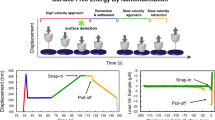Abstract
Here, we report on a special tribometer built to operate inside an environmental scanning electron microscope enabling charge-free imaging of non-conductive and/or hydrated materials. The device is intended to be used for simultaneous testing and in situ visual inspection of biological and biomimetic patterned surfaces during contact formation, pulling-off, peeling, and shearing modeling the behavior of biological microstructured attachment systems in nature. To demonstrate its performance, a simple array of hexagonal elastomer micropillars is tested. The results obtained show that direct link between precise data on the contact forces and images of the contact elements deformed by these forces indeed allows getting an insight into how contact surface patterns function when in contact.





Similar content being viewed by others
References
Creton, C., Gorb, S.: Sticky feet: from animals to materials. MRS Bull. 32, 466–472 (2007)
Scherge, M., Gorb, S.: Biological Micro- and Nanotribology: Nature’s Solutions. Springer, Berlin (2001)
Gorb, S.N.: Functional surfaces in biology: mechanisms and applications. In: Bar-Cohen, Y. (ed.) Biomimetics: Biologically Inspired Technologies, pp. 381–397. CRC Press, Boca Raton (2006)
Parness, A., Soto, D., Esparza, N., Gravish, N., Wilkinson, M., Autumn, K., Cutkosky, M.: A microfabricated wedge-shaped adhesive array displaying gecko-like dynamic adhesion, directionality and long lifetime. J. R. Soc. Interface 6, 1223–1232 (2009)
Autumn, K., Liang, Y.A., Hsieh, S.T., Zesch, W., Chan, W.P., Kenny, T.W., Fearing, R., Full, R.J.: Adhesive force of a single gecko foot-hair. Nature 405, 681–685 (2000)
Hui, C.Y., Glassmaker, N.J., Tang, T., Jagota, A.: Design of biomimetic fibrillar interfaces: 2. Mechanics of enhanced adhesion. J. R. Soc. Interface 1, 35–48 (2004)
Jiao, Y., Gorb, S., Scherge, M.: Adhesion measured on the attachment pads of Tettigonia viridissima (Orthoptera Insecta). J. Exp. Biol. 203, 1887–1895 (2000)
Greiner, C., del Campo, A., Arzt, E.: Adhesion of bioinspired micropatterned surfaces: effects of pillar radius, aspect ratio, and preload. Langmuir 23, 3495–3502 (2007)
Federle, W., Barnes, W.J.P., Baumgartner, W., Drechsler, P., Smith, J.M.: Wet but not slippery: boundary friction in tree frog adhesive toe pads. J. R. Soc. Interface 3, 689–697 (2006)
Varenberg, M., Gorb, S.: Shearing of fibrillar adhesive microstructure: friction and shear-related changes in pull-off force. J. R. Soc. Interface 4, 721–725 (2007)
Crosby, A.J., Hageman, M., Duncan, A.: Controlling polymer adhesion with “pancakes”. Langmuir 21, 11738–11743 (2005)
Varenberg, M., Gorb, S.: Close-up of mushroom-shaped fibrillar adhesive microstructure: contact element behaviour. J. R. Soc. Interface 5, 785–789 (2008)
Murphy, M.P., Aksak, B., Sitti, M.: Gecko-inspired directional and controllable adhesion. Small 5, 170–175 (2009)
Gane, N., Bowden, F.P.: Microdeformation of solids. J. Appl. Phys. 39, 1432–1435 (1968)
Guo, S.Y., Li, J., Mao, D.S., Xu, M.H., Mao, Z.Y.: The friction-wear behavior of Al2O3–TiC–Co advanced ceramic during in situ SEM. Wear 203–204, 319–324 (1997)
Orso, S., Wegst, U.G.K., Eberl, C., Arzt, E.: Micrometer-scale tensile testing of biological attachment devices. Adv. Mater. 18, 874–877 (2006)
Eberl, C., Saif, T.: In situ mechanical testing of biological and inorganic materials at the micro- and nanoscales. MRS Bull. 35, 347–350 (2010)
Varenberg, M., Peressadko, A., Gorb, S., Arzt, E., Mrotzek, S.: Advanced testing of adhesion and friction with a microtribometer. Rev. Sci. Instrum. 77, 066105 (2006)
Glassmaker, N.J., Jagota, A., Hui, C.-Y., Noderer, W.L., Chaudhury, M.K.: Biologically inspired crack trapping for enhanced adhesion. Proc. Natl. Acad. Sci. USA 104, 10786–10791 (2007)
Varenberg, M., Gorb, S.: Hexagonal surface micropattern for dry and wet friction. Adv. Mater. 21, 483–486 (2009)
Acknowledgments
We thank Grigory Halperin for the fruitful discussions, and Yan Itovich and Svetlana Yofis for the template preparation performed in clean room of the Technion Microelectronics Research Center.
Author information
Authors and Affiliations
Corresponding author
Rights and permissions
About this article
Cite this article
Murarash, B., Varenberg, M. Tribometer for In Situ Scanning Electron Microscopy of Microstructured Contacts. Tribol Lett 41, 319–323 (2011). https://doi.org/10.1007/s11249-010-9717-y
Received:
Accepted:
Published:
Issue Date:
DOI: https://doi.org/10.1007/s11249-010-9717-y




